Indian Buead|Tuckahoe
Poria
Functions:Promotes urination, leaches out dampness, fortifies the spleen and stomach, calms spirit. Apply to dysuria, edema, phlegm and retained fluid and cough, vomiting, less intake due to deficiency of spleen, diarrhea, and fright and nervous, insomnia and amnesia, spermatorrhea and gonorrhea.
